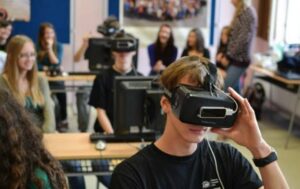How Virtual Reality In Education is Transforming the Way We Learn in 2023
Introduction
Virtual Reality (VR) – Welcome to the year 2023! It’s been a wild ride since the start of the 2020s. The world has seen some amazing technological advances, and one of the most notable has been the rise of Virtual Reality in Education. Virtual Reality is being used to create immersive learning experiences in the classroom, allowing students to explore and learn in ways never before possible. In this article, we will explore how Virtual Reality in Education is transforming the way we learn in 2023.
What is Virtual Reality?
Virtual Reality (VR) is a computer-generated environment that allows users to interact with and explore 3D worlds. It is a simulated reality, where the user can immerse themselves completely in a virtual world. This technology is being used in classrooms around the world, allowing students to experience and understand concepts in a way they never could before.
The Benefits of Virtual Reality in Education
Virtual Reality in Education has many benefits. For one, it allows students to learn in a more engaging way. By creating immersive, interactive learning environments, VR can make learning more enjoyable and help students better understand and retain the material. Additionally, VR can make learning more accessible, as it can be used to create virtual classrooms in remote locations.
VR in the Classroom
Virtual Reality in Education is being used to create virtual classrooms in which students can explore, interact, and learn. These virtual classrooms provide students with the opportunity to explore their studies in a more engaging way. For example, students can take a virtual tour of a museum or explore a foreign city, or even visit the inside of a cell or the surface of the moon. This allows students to gain a deeper understanding of the material than traditional methods of teaching would allow.
The Future of Virtual Reality in Education
Virtual Reality in Education is continuing to evolve and expand. In the future, we can expect to see even more ways in which VR can be used to enhance and improve the learning experience. With advances in technology, we can expect to see more interactive and immersive learning experiences, as well as more applications of Virtual Reality in Education. It is an exciting time to be alive, and the possibilities are virtually limitless.
How Virtual Reality Can Help Environmental Education
The Role of Virtual Reality in Environmental Education
Environmental education is a critical component in teaching people about the value of nature and the importance of conservation. Virtual reality (VR) is an emerging technology that is being used to help educate people about the environment. This technology has the potential to bring environmental education to a new level, providing an immersive experience that can help students learn about their environment in a more engaging way.
Advantages of Virtual Reality in Environmental Education
There are many advantages to using virtual reality in environmental education. One of the most important advantages is that it allows students to experience the environment without being physically present. This can be especially beneficial for students who may not be able to visit certain areas due to geographical or financial constraints. Additionally, virtual reality allows students to interact with their environment in a more immersive way, allowing them to explore areas they may not be able to access in real life.
Examples of Virtual Reality in Environmental Education
Virtual reality technology is being used in a variety of ways to educate people about their environment. For example, virtual field trips can be taken to explore different ecosystems and observe wildlife in their natural habitats. Additionally, virtual reality can be used to teach students about the impact of climate change on their environment. Finally, virtual reality can be used to promote conservation practices, giving students the opportunity to “explore” different strategies for protecting their environment.
Challenges of Virtual Reality in Environmental Education
Although virtual reality has the potential to be a powerful tool for environmental education, there are some challenges that must be addressed. For example, virtual reality technology is still relatively new and can be expensive, making it difficult for some schools to access. Additionally, virtual reality experiences can be difficult to design and may not provide the same level of interactivity as a real-life experience. Finally, virtual reality technology is still being developed, so it is unclear how effective it will be in the long-term.
Conclusion
Virtual reality technology has the potential to be a powerful tool for environmental education. By providing an immersive experience, virtual reality can help students learn about their environment in a more engaging way. However, there are still some challenges that must be addressed in order for virtual reality to be effective, such as cost and the difficulty of designing experiences. Despite these challenges, virtual reality has the potential to revolutionize the way environmental education is taught.

